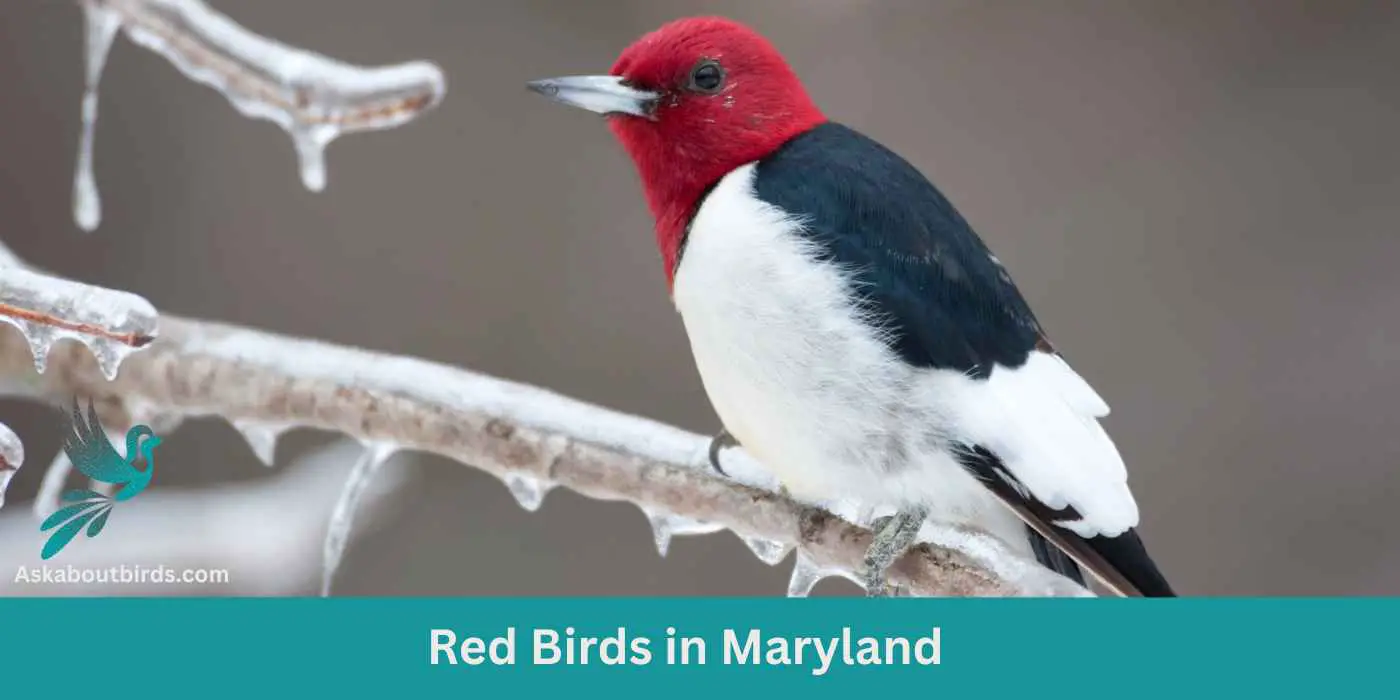Maryland, spanning the Atlantic coast to the Appalachian Mountains, offers a blend of coastal, urban, and forested terrains. From the bustling harbors of Annapolis to the tranquil shores of the Chesapeake Bay, Maryland’s diverse landscapes are home to a myriad of bird species.
Among them, the state boasts a spectacular array of red birds, each with its unique charm and beauty.
Our guide introduces you to 11 of these radiant avians that grace the skies and woodlands of Maryland. Whether you’re an avid birder or a curious novice, our free photo guide will help you identify and appreciate the crimson-feathered wonders of this Mid-Atlantic gem.
Red Birds Found In Maryland
Maryland’s geographical diversity makes it a haven for birds. From the sandy shores of the Chesapeake Bay to the lush heights of the Appalachian Mountains, this state provides a plethora of habitats.
The state’s numerous wetlands, hardwood forests, grasslands, and urban areas create niches for various bird species to thrive.
Northern Cardinal


| Feature | Measurement |
|---|---|
| Scientific Name | Cardinalis cardinalis |
| Length | 8.3 – 9.1 in |
| Wingspan | 9.8 – 12.2 in |
| Weight | 1.19 – 2.29 oz |
The Northern Cardinal is an iconic North American bird, easily recognized by its vibrant color and melodious song.
Appearance: Male Northern Cardinals are a brilliant scarlet red, while females display a more subdued reddish olive. Both sexes have a distinctive black ‘mask’ on their face around the bill and a pointed crest on their head. The bird’s beak is robust, cone-shaped, and bright orange in color.
Diet: Northern Cardinals are primarily granivorous, with a diet largely consisting of seeds and grains. They also eat fruits and insects. These birds typically feed off the ground and are frequent visitors to bird feeders.
Reproduction: Northern Cardinals are monogamous, and a pair will breed together for life. The female typically builds a well-hidden nest in a dense thicket or shrub. She lays 2-5 eggs per clutch, which she incubates for around two weeks.
Scarlet Tanager


| Feature | Measurement |
|---|---|
| Scientific Name | Piranga olivacea |
| Length | 6.3 to 7.5 in |
| Wingspan | 9.8 to 11.8 in |
| Weight | 23.5 to 38 g |
The Scarlet Tanager is a strikingly colorful bird known for its brilliant plumage and distinctive song.
Appearance: Male Scarlet Tanagers are notable for their vibrant scarlet bodies contrasted with black wings and tail, making them one of the most intensely colored birds. Females and juveniles, on the other hand, have a subdued olive-yellow body color with darker wings and tail.
Diet: The diet of the Scarlet Tanager is largely made up of insects, including beetles, cicadas, aphids, and others. They are adept flycatchers, seizing insects in mid-air or picking them off foliage. They also consume fruits and berries, especially during migration and in their winter habitats.
Reproduction: The female Scarlet Tanager builds a cup-shaped nest using twigs, rootlets, and grass, typically well-hidden in the dense foliage of trees. She lays 3 to 5 eggs and incubates them for about two weeks.
Red-bellied Woodpecker
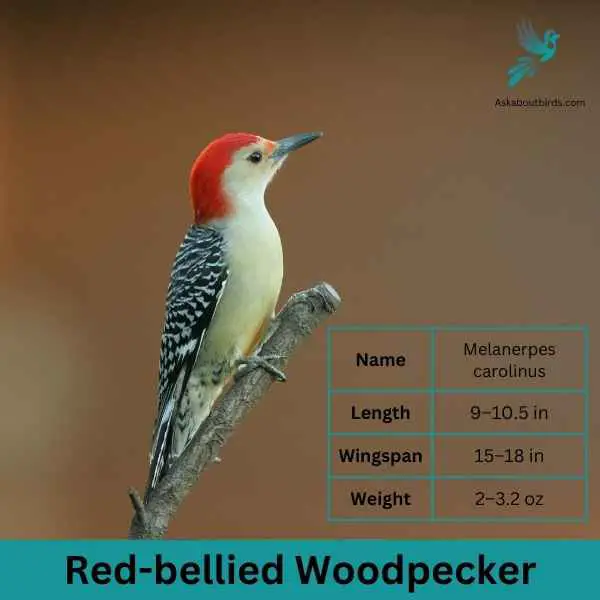
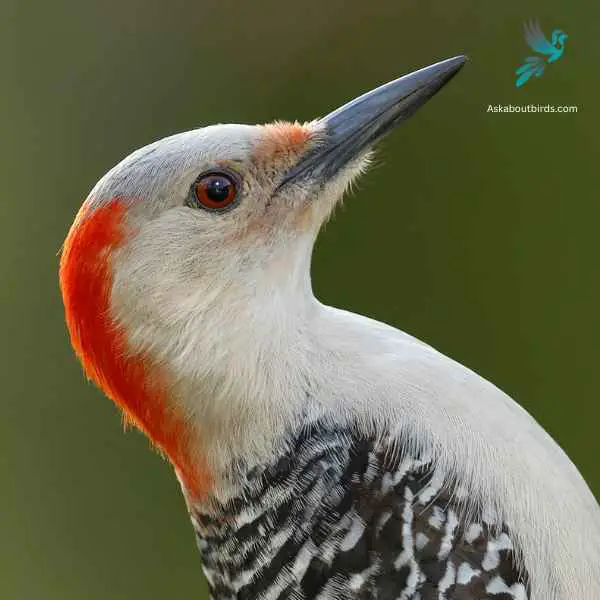
| Feature | Measurement |
|---|---|
| Scientific Name | Thryothorus ludovicianus |
| Length | 4.7–5.5 in |
| Wingspan | 11 in |
| Weight | 0.63–0.81 oz |
The Red-bellied Woodpecker is a medium-sized woodpecker commonly found in woodlands, forests, and backyards across the eastern and central U.S.
Appearance: The Red-bellied Woodpecker sports a pale gray face, throat, and belly, contrasted by a zebra-striped back. Its name derives from the subtle reddish tinge on its belly, but it’s more commonly recognized by the vivid red cap on the head of males and the partial red cap on females.
Diet: This woodpecker has a varied diet that includes insects, fruits, nuts, and seeds. They frequently forage on tree trunks and branches, using their sticky, barbed-tipped tongue to extract ants, beetles, and other insects from crevices.
Reproduction: Red-bellied Woodpeckers are cavity nesters, excavating holes in tree trunks for their nests. The inside of the nest is typically unlined or sparingly lined with wood chips.
Red-Winged Blackbird
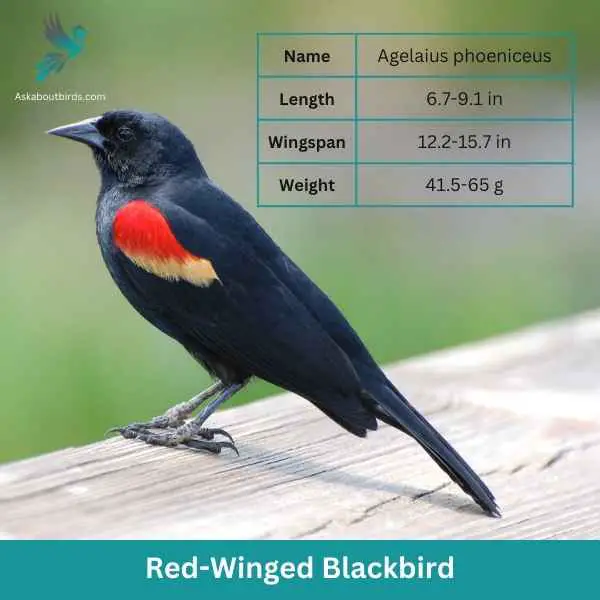
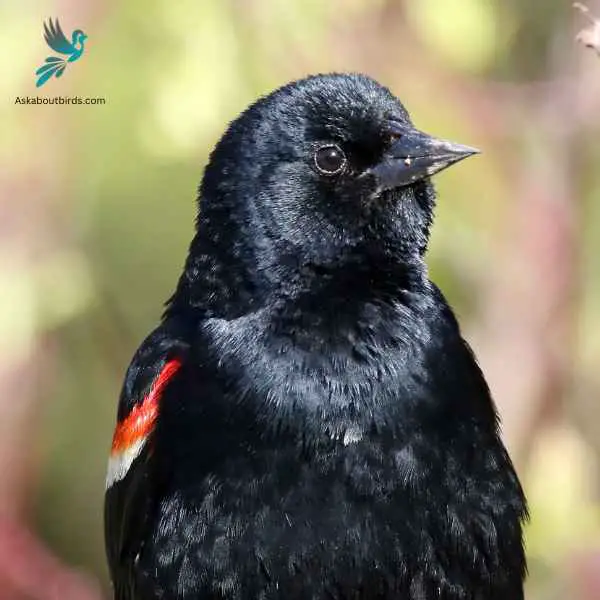
| Feature | Measurement |
|---|---|
| Scientific Name | Agelaius phoeniceus |
| Length | 6.7-9.1 in |
| Wingspan | 12.2-15.7 in |
| Weight | 41.5-65 g |
The Red-Winged Blackbird is a familiar sight across North America, especially in wetlands and open areas. Known for its striking coloration and distinct call, it is often seen perched on cattails or utility lines.
Appearance: Male Red-Winged Blackbirds are glossy black with bright red-and-yellow shoulder patches, while females are streaky brown, resembling a large sparrow. The males’ red patches become more prominent when they’re displaying or agitated.
Diet: Red-Winged Blackbirds primarily feed on seeds and insects. Their diet includes grains, sunflower seeds, and corn, but they also eat beetles, caterpillars, and other small invertebrates, especially in the breeding season.
Reproduction: Red-Winged Blackbirds nest in marshes, along watercourses, and in wet fields. The female constructs a cup-shaped nest using grass and sedge, attaching it to plants above water. She typically lays a clutch of 3 to 4 blue-green eggs, which she incubates for about 11-12 days. Males, being polygynous, often have multiple mates during a single breeding season.
American Redstart


| Feature | Measurement |
|---|---|
| Scientific Name | Setophaga ruticilla |
| Length | 4.3 to 5.5 in |
| Wingspan | 6.3 to 9.1 in |
| Weight | 8.6 g |
The American Redstart is a lively warbler known for its vivid colors and active hunting style, often seen flitting about, fanning its tail to startle and catch insects.
Appearance: Adult male American Redstarts boast striking black plumage with bright orange patches on the sides, wings, and tail. Females and immature males have grayish-olive upperparts with yellow patches in the same areas where the males display orange.
Diet: American Redstarts are primarily insectivores. They actively forage for flying insects, as well as caterpillars and spiders, often using their colorful tails to startle prey and make them easier to catch.
Reproduction: The female American Redstart builds a cup-shaped nest in the fork of a tree branch. Typically, she lays a clutch of 3 to 5 eggs. The female takes on the primary responsibility of incubating the eggs, while both parents participate in feeding the fledglings after they hatch.
House Finch


| Feature | Measurement |
|---|---|
| Scientific Name | Haemorhous mexicanus |
| Length | 5–6 in |
| Wingspan | 8–10 in |
| Weight | 0.6–0.9 oz |
The House Finch is a small songbird widely distributed across North America and is commonly found in urban and suburban areas.
Appearance: Males of this species are brightly colored with crimson faces and throats, which can extend to the chest and back, while their flanks have streaks. The female is streaked brown and lacks the red coloring. Both have a square-tipped tail and a distinctively long, flat-topped bill.
Diet: House Finches primarily eat seeds, grains, and berries. They have a particular fondness for sunflower seeds and can be commonly seen at bird feeders. Occasionally, they will also consume insects, especially during the breeding season.
Reproduction: House Finches are cavity-nesters and might choose ledges, vents, ledges, and other urban settings. They might also utilize trees or shrubs. Their nests can be made of a wide array of materials, from feathers to twigs.
Red-Tailed Hawk
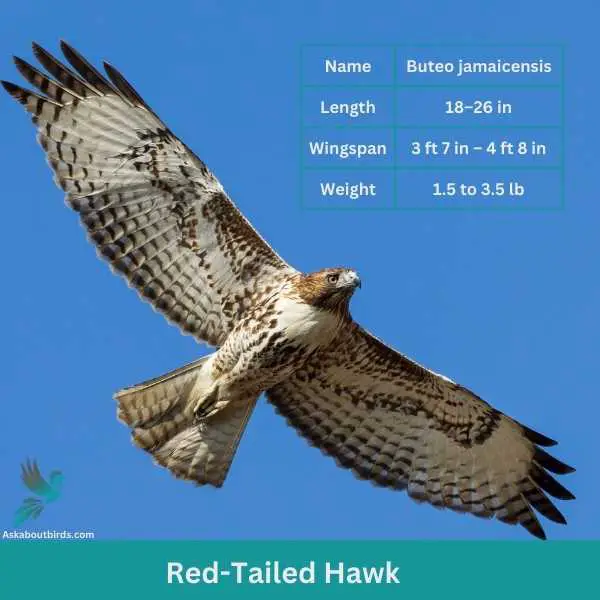
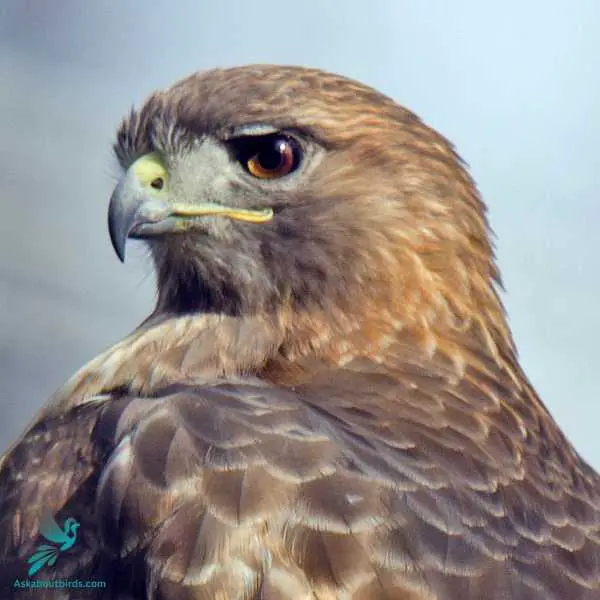
| Feature | Measurement |
|---|---|
| Scientific Name | Buteo jamaicensis |
| Length | 45–65 cm (18–26 in) |
| Wingspan | 110–141 cm (3 ft 7 in – 4 ft 8 in) |
| Weight | 690 to 1,600 g (1.5 to 3.5 lb) |
The Red-Tailed Hawk is a bird of prey that is commonly found across North America. This adaptable raptor is known for its brick-red tail, which is most noticeable in adults from above or underneath. The diet of the Red-Tailed Hawk is very diverse, including small mammals like mice and squirrels, as well as birds and reptiles.
This hawk is often seen perched on poles or soaring in wide circles high above fields, forests, and highways. Its habitat is extremely varied, ranging from desert and scrublands to forests and tropical rainforests. Its call, a raspy, screaming kee-eeeee-arr, is often used in movies to represent any bird of prey.
Red-headed Woodpecker


| Feature | Measurement |
|---|---|
| Scientific Name | Melanerpes erythrocephalus |
| Length | 7.5–9.1 in |
| Wingspan | 16.5 in |
| Weight | 2.0–3.2 oz |
The Red-headed Woodpecker is a striking forest bird with a bold tri-colored pattern.
Appearance: This woodpecker features a completely red head and neck, contrasting starkly with its white underparts and black wings. Its wings also have large white patches which are conspicuous in flight.
Diet: Red-headed Woodpeckers have a varied diet including insects, seeds, fruits, berries, and occasionally even the eggs of other birds. They’re also known to store food by wedging it into crevices in bark.
Reproduction: These woodpeckers nest in cavities which they excavate in dead wood or dead parts of live trees. These cavities can be found anywhere from 2 to 80 feet off the ground.
Rose-breasted Grosbeak


| Feature | Measurement |
|---|---|
| Scientific Name | Pheucticus ludovicianus |
| Length | 7.5-8.5 in |
| Wingspan | 12.5-13 in |
| Weight | 1.2-1.7 oz |
The Rose-breasted Grosbeak is a songbird of medium size, widely recognized for its vibrant coloration and melodious song.
Appearance: Male Rose-breasted Grosbeaks boast a striking contrast with black and white plumage accompanied by a radiant rose-colored patch on the chest and under the wings. In contrast, females exhibit streaked brown and white plumage, resembling large sparrows but with a thick bill.
Diet: The diet of the Rose-breasted Grosbeak consists of a mixture of seeds, insects, and fruits. During summer, they primarily feed on insects, while seeds and fruits become more prevalent in their diet during the colder months.
Reproduction: These birds build cup-shaped nests typically situated in trees or large shrubs. Both the male and female partake in incubation duties, ensuring the eggs’ safety and warmth. After hatching, the chicks are primarily fed insects.
Eastern Towhee


| Feature | Measurement |
|---|---|
| Scientific Name | Pipilo erythrophthalmus |
| Length | 6.8 to 9.1 in |
| Wingspan | 7.9–11.8 in |
| Weight | 32 to 53 g |
The Eastern Towhee is a distinctive songbird known for its unique calls and eye-catching coloration.
Appearance: Male Eastern Towhees are characterized by a striking combination of a black head, back and tail, contrasting with a white belly and rufous flanks. Females sport similar patterns but instead of black, they have a rich brown color. Both genders have red eyes, lending a special charm to their overall appearance.
Diet: Eastern Towhees primarily feed on a variety of insects, seeds, and berries. Their diet is quite diverse, taking advantage of seasonal offerings, which includes beetles, caterpillars, spiders, acorns, grass seeds, and various fruits and berries.
Reproduction: Eastern Towhees build their nests on or near the ground, often in a shrub or a small tree. The female lays around 3-5 eggs and takes the primary role in incubating them over about 12-13 days.
Summer Tanager
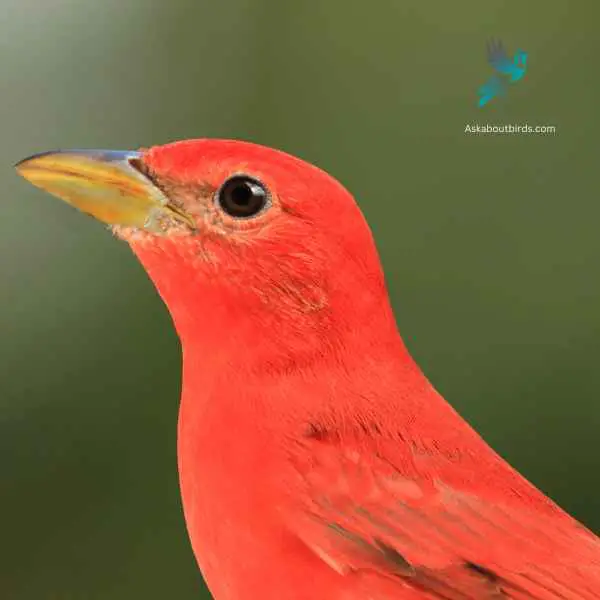
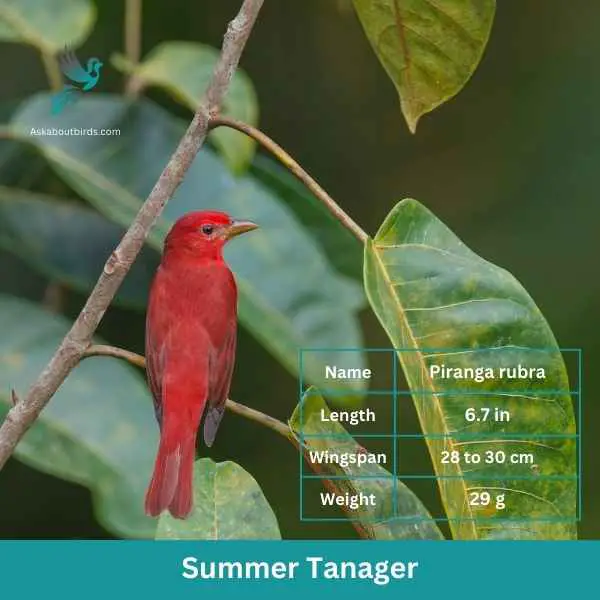
| Feature | Measurement |
|---|---|
| Scientific Name | Piranga rubra |
| Length | 6.7 in |
| Wingspan | 28 to 30 cm |
| Weight | 29 g |
The Summer Tanager is a medium-sized songbird admired for its radiant plumage and melodious song.
Appearance: Male Summer Tanagers are an impressive bright red, while females and juveniles present a softer, yellow-orange color. Both genders have a large, slightly hooked bill and relatively short tail.
Diet: Summer Tanagers primarily feed on insects, including bees and wasps, which they catch in flight or pick off vegetation. They are also known to eat fruits and berries, making them helpful in controlling pest populations and seed dispersal.
Reproduction: The female Summer Tanager builds a loose, shallow cup-shaped nest out of twigs and grass, usually hidden in the foliage of trees. The female typically lays 3-5 eggs, which she will incubate for about two weeks.
Where to Spot Maryland’s Red Birds
Maryland, with its unique topography, is a dream come true for bird enthusiasts. Here are some of the state’s prime spots where the diversity of birds, especially the vibrant red ones, can leave you spellbound:
- Blackwater National Wildlife Refuge, Cambridge: A vast expanse of tidal marsh and mixed forests, this refuge is a hub for migratory waterfowl and songbirds. The serene landscapes also offer glimpses of various red birds against the backdrop of open waters.
- Patuxent Research Refuge, Laurel: Established to support wildlife research, the refuge is an ideal spot for bird watching. Its diverse habitats, ranging from wetlands to hardwood forests, are home to numerous red avian species and other birds.
- Catoctin Mountain Park: Nestled within the Blue Ridge Mountains, this park boasts dense deciduous forests, making it an excellent locale for spotting woodland birds. The contrast of red birds against the lush green is truly mesmerizing.
- Assateague Island National Seashore: A coastal wonder, the island is not only famous for its wild horses but also as a birding hotspot. The barrier island’s habitats vary from sandy beaches to salt marshes, attracting a wide variety of birds.
- Point Lookout State Park: Located at the confluence of the Potomac River and the Chesapeake Bay, this park provides a unique mix of woodland, wetland, and shoreline habitats. Birders can enjoy spotting both coastal birds and vibrant red inland species.
| State’s Red Birds | Best Spots for Red Birds |
|---|---|
| Delaware’s Red Birds | 1. Bombay Hook National Wildlife Refuge 2. Cape Henlopen State Park 3. Prime Hook National Wildlife Refuge |
| Pennsylvania’s Red Birds | 1. Hawk Mountain Sanctuary 2. Presque Isle State Park 3. John Heinz National Wildlife Refuge at Tinicum |
| Virginia’s Red Birds | 1. Shenandoah National Park 2. Great Dismal Swamp National Wildlife Refuge 3. Chincoteague National Wildlife Refuge |
| West Virginia’s Red Birds | 1. Canaan Valley National Wildlife Refuge 2. New River Gorge National Park and Preserve 3. Monongahela National Forest |
FAQs on Red Bird Species Found in Maryland
What makes black oil sunflower seeds popular among birds?
Black oil sunflower seeds are favored by many bird species, making them a staple for backyard bird feeders. Their high oil content provides essential nutrition, attracting both migratory birds and year round full-round residents. Notably, birds such as the purple finch, with its striking red plumage, and the medium-sized blue jay with its bright blue and white markings, frequent backyard feeders offering these seeds.
How can one differentiate between a purple finch and other red birds?
The purple finch, despite its name, flaunts a bright red plumage which can be easily mistaken for other bright red birds elsewhere. However, distinct features such as two white wing bars, reddish-brown sides, and a long tail help in distinguishing it. Predominantly found in the eastern half of North America, they are known to visit bird feeders and consume black oil sunflower seeds.
What habitats do ruby throated hummingbirds prefer?
Ruby throated hummingbirds, characterized by their bright yellow-green body and rapid wing movement, are predominantly found in the eastern United States. They have a preference for forest edges and the forest canopy, especially areas abundant in flowering plants. These hummingbirds are migratory, often traveling between Central and South America during different seasons.
Why are bird feeders beneficial for common backyard birds?
Bird feeders, especially those stocked with black oil sunflower seeds, serve as reliable food sources for many of most common backyard birds here. Such feeders support both resident and migratory species, ensuring they receive essential nutrients. By attracting species like the downy woodpecker or the shy birds with striking red plumage, visit bird feeders enhance bird-watching experiences.

